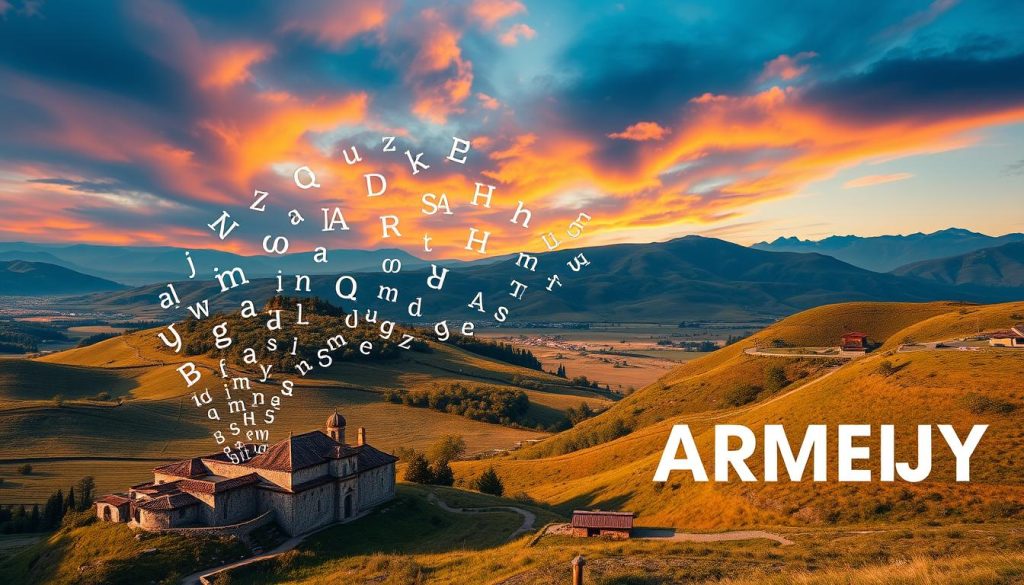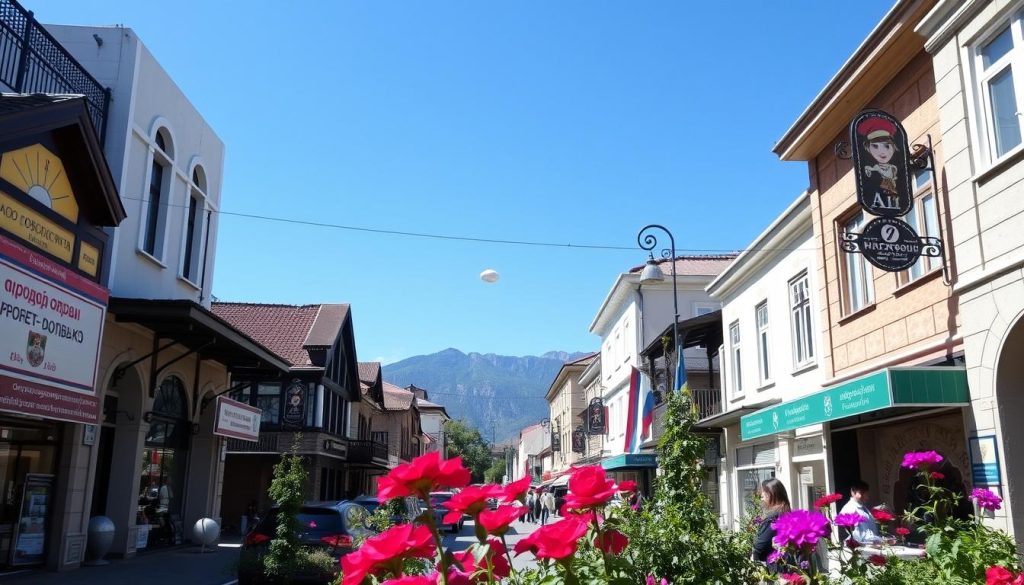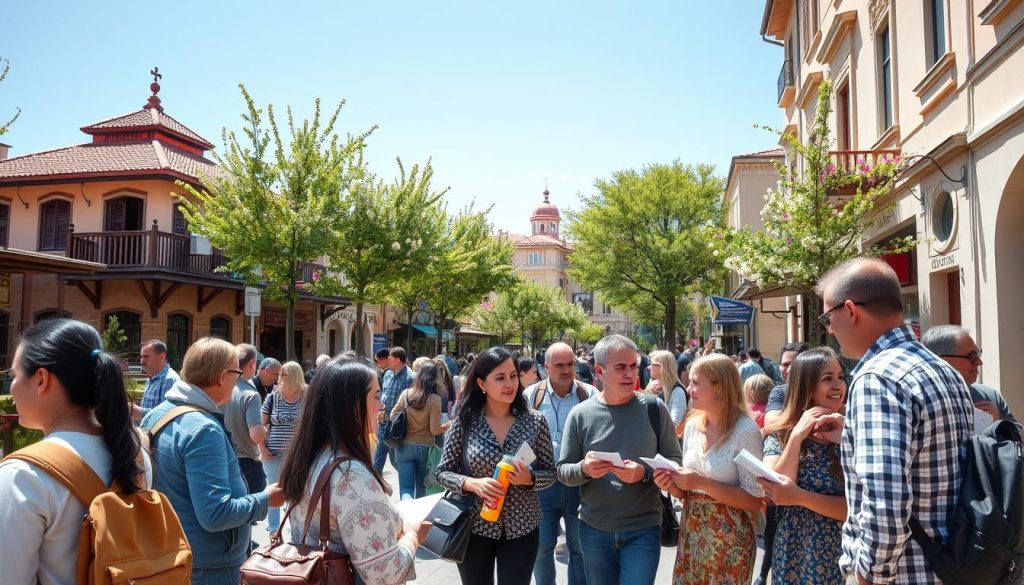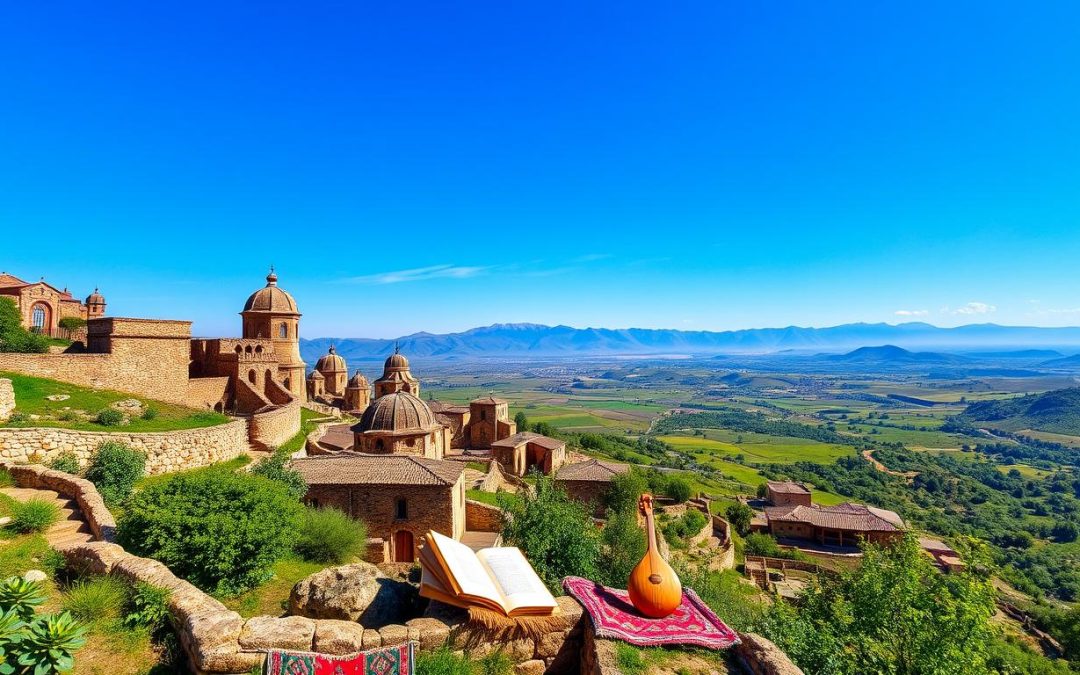Ever thought about how a small nation in the Caucasus handles its language? Armenia’s language scene is complex and interesting. It mixes culture, history, and today’s ways of talking.
Armenian is the main language of Armenia. It’s key to the country’s identity. In Yerevan and everywhere, it connects people to Armenia’s deep cultural past.
The Armenian language has two main types: Eastern and Western Armenian. Eastern Armenian is used in government, business, and everyday talk. But the language’s variety shows Armenia’s complex history.
Key Takeaways
- Armenian is the official language spoken by the majority of the population
- Two primary forms exist: Eastern and Western Armenian
- Approximately 70% of Armenians have basic Russian language skills
- The Armenian alphabet is unique and distinct from other writing systems
- Language reflects Armenia’s rich cultural and historical heritage
Understanding Armenian as the Official Language
Armenian is a special language in the Indo-European family. It has deep roots and a unique character. It’s not just a way to talk; it’s a big part of Armenia’s culture.

The Armenian language broke off from the Indo-European family. It has two main types: Eastern Armenian and Western Armenian. Each shows the history of the Armenian people in its own way.
Origins and Development of Armenian
Armenian started in the 5th century CE. It has a rich literary history of over 1,500 years. The language shows how strong Armenian culture is:
- Documented since the 5th century CE
- Approximately 50-60 historical dialects
- Connected to other Indo-European languages like Sanskrit and Greek
The Armenian Alphabet System
The Armenian alphabet was created by Mesrop Mashtots. It started with 36 letters and grew to 39 in the early 20th century. This alphabet is key to keeping Armenian culture alive.
“The Armenian alphabet is not just a means of writing, but a guardian of cultural memory” – Armenian Linguistic Scholar
Constitutional Status of Armenian
Article 20 of the Armenian Constitution makes Armenian the official language. This shows how important it is to the country’s identity. Eastern Armenian is used in Armenia, while Western Armenian is important for Armenians around the world.
Today, Armenian has about 6.5 million speakers. It’s a lively language that connects old traditions with today’s needs.
Evolution of Language Use in Modern Armenia

Since gaining independence in 1991, Armenia’s language scene has changed a lot. The country has worked hard to keep its language diverse and strong. This is after years of Soviet rule.
After the Soviet era, Armenia changed a lot in how it uses language. It became a leader in making Armenian the main language in society.
“Language is the roadmap of a culture. It tells you where its people come from and where they are going.” – Rita Mae Brown
Key Linguistic Developments
- Promotion of Armenian as the primary language in government
- Expansion of Armenian-language education
- Reduction of Russian language influence
- Preservation of linguistic cultural heritage
Armenia has worked hard to keep its language diverse. By focusing on Armenian, the country has kept its roots while staying open to the world.
Language Demographic Insights
| Language Category | Percentage | Speakers |
|---|---|---|
| Armenian Native Speakers | 97.9% | 3.4 Million |
| Russian Speakers | 1.5% | 50,000 |
| Other Languages | 0.6% | 20,000 |
Armenia’s language use shows its dedication to keeping its culture alive. By choosing Armenian, the country has smoothly moved past its Soviet past.
Russian Language Influence and Usage
The Russian language has deeply influenced Armenia’s culture and history. It has created a rich cultural tapestry. Even after Armenia gained independence, Russian remains important in many areas of society.

Historical Roots of Russian Language
In the Soviet era, Russian became a big part of Armenian life. It spread through:
- Educational systems
- Government institutions
- Media channels
- Professional networks
Current Language Dynamics
About 70% of Armenia’s population still knows some Russian. Although fewer people speak it natively, Russian is still key in:
- Business communications
- International diplomatic relations
- Technical and scientific exchanges
Russian in Armenian Education
Education policies have changed how Russian is taught. By 1994, there were no Russian-language schools left. Now, Armenian schools barely teach Russian, with only 6 Armenian classes for every Russian one.
“Language is the roadmap of a culture. It tells you where its people come from and where they are going.” – Rita Mae Brown
English is becoming more popular, but Russian is still valuable. It’s especially useful in professional and international settings, especially when dealing with Turkic languages and regional communication.
The Rise of English in Armenian Society

English has become a big change in Armenian society since 1991. It has grown fast, showing Armenia’s desire to connect with the world. Now, more people speak English than ever before.
Recent census data shows a big change in English speaking:
- 60% of Armenian citizens now report English proficiency
- Urban youth show even higher rates, with 75% speaking English
- English is now taught in 90% of Armenian schools
Businesses in Armenia love English, with over 70% using it. This helps Armenian companies reach out to the world. It opens doors to new trade and job chances for Armenians.
“Language is the roadmap of a culture. It tells you where its people come from and where they are going.” – Rita Mae Brown
For young people, English is more than just talking. It’s a way to connect with the world. About 50% of university students take English courses. This shows how important English is for their future.
Even with English becoming more popular, Armenia still values its minority languages. The country wants to keep its cultural heritage alive. It makes sure English doesn’t replace Armenian languages.
Knowing English can really help you in Armenia today. Jobs often prefer people who speak English. So, learning English is a smart choice for those who want to succeed.
Language Distribution Demographics
Armenia’s language diversity shows a complex social scene. Language is key in talking across different areas and groups. With over 3 million people, the country has unique language patterns. These patterns change a lot between cities and countryside.
To understand Armenia’s language diversity, we need to look at several aspects:
- Armenian is the main official language, spoken by 97.9% of people
- Russian has a big impact on talking
- Minority languages add to the nation’s cultural wealth
Urban Language Dynamics
In cities like Yerevan, language diversity is more clear. The capital city has a more varied language scene than rural areas. Young people are more flexible with languages.
Sectoral Language Usage
Different jobs in Armenia have their own language choices:
- Government: Mostly Armenian with a lot of Russian understanding
- Business: More English is being used
- Technology: Uses Russian and English a lot
- Education: Focuses on speaking many languages
The language scene in Armenia is always changing. It shows the country’s growing culture and economy.
Minority Languages and Cultural Diversity
Armenia is a vibrant mix of languages, showing great support for its minority languages. By signing the European Charter for Regional or Minority Languages in 2001, Armenia showed its commitment to keeping languages diverse.
In Armenia, you’ll find many interesting language groups:
- Kurdish language speakers
- Assyrian language communities
- Greek language populations
“Language is the roadmap of a culture. It tells you where its people come from and where they are going.” – Rita Mae Brown
Each minority language adds a special thread to Armenia’s culture. The Kurdish language, with its deep storytelling, is protected alongside the Assyrian and Greek languages.
| Minority Language | Estimated Speakers | Cultural Significance |
|---|---|---|
| Kurdish language | Approximately 2,000-3,000 | Ancient nomadic traditions |
| Assyrian language | Around 3,000-4,000 | Mesopotamian cultural roots |
| Greek language | Roughly 1,500-2,500 | Historical Mediterranean connections |
These languages keep cultural memories alive and add to Armenia’s rich mix of cultures. The government works hard to make sure these languages stay alive in today’s Armenia.
Foreign Language Education and Institutions
Armenia’s language education scene is lively and varied. It offers many ways to learn international languages. This prepares students for a world that’s more connected than ever.
The country has built a strong base for learning languages. Many universities in Yerevan are leading the way. They help students learn many languages.
Language Learning Centers
Armenia’s language education centers focus on giving students a deep understanding of languages. Key places include:
- Yerevan State Linguistic University
- American University of Armenia
- Russian-Armenian University
International Educational Partnerships
Armenia has formed partnerships to improve language education. These partnerships offer students:
- Access to international curricula
- Opportunities for exchange programs
- Chances to develop skills in many languages
Language Teaching Methodologies
Modern language education in Armenia uses new methods. Communicative approaches and technology help students learn by doing. This makes learning languages more practical.
“Language learning is not just about grammar, but about connecting with different cultures and perspectives.” – Armenian Language Education Expert
About 40% of Armenians know basic English, and over 70% know Russian. The country keeps working on new ways to teach languages.
Language Preservation and Policy Initiatives
Armenia is a leader in keeping languages alive in South Caucasian states. Its language policies aim to protect and promote its national language. They also meet global communication needs.
The government has set up important language policies. These policies help strengthen Armenian’s linguistic identity:
- Promoting Eastern Armenian as the standard national language
- Supporting comprehensive language education programs
- Protecting minority language rights through legislative frameworks
- Encouraging multilingual competencies among citizens
Key initiatives focus on maintaining the purity and vitality of the Armenian language while simultaneously recognizing the importance of international communication skills.
“Language is the roadmap of a culture. It tells you where its people come from and where they are going.” – Rita Mae Brown
Armenia’s language policies have successfully balanced cultural preservation and global integration. By joining the European Charter for Regional or Minority Languages in 2001, the country showed its dedication to linguistic diversity and protection.
The national strategy includes:
- Strengthening Armenian language education
- Supporting minority language communities
- Developing robust translation and interpretation infrastructure
- Creating opportunities for language skill development
These forward-thinking language policies ensure Armenia keeps its rich linguistic tradition. They also prepare its citizens for a more connected world.
Conclusion
Your journey through Armenia’s linguistic world shows a rich mix of communication. The Armenian language is key to national identity, with 98% of people speaking it. It shows the deep cultural ties that connect Armenians across different areas.
Linguistic diversity in Armenia is both interesting and complex. While Armenian is the main language, Russian and English are also important. This mix allows for cultural exchange and personal growth, helping people connect with both local and global cultures.
The future of language in Armenia is bright and changing. There are about 2.9 million Eastern Armenian speakers and 1.2 million Western Armenian speakers. Young Armenians are learning many languages, preparing them for the global world while keeping strong ties to their heritage.
Exploring Armenia’s linguistic landscape, you’ll see a balance of tradition and innovation. The country is dedicated to keeping the Armenian language alive while also using global communication. This shows Armenia’s ability to adapt and its strong cultural identity.
The above is subject to change.
Check back often to TRAVEL.COM for the latest travel tips and deals.
Here are some Tours & Sightseeing suggestions that might pique your interests!
